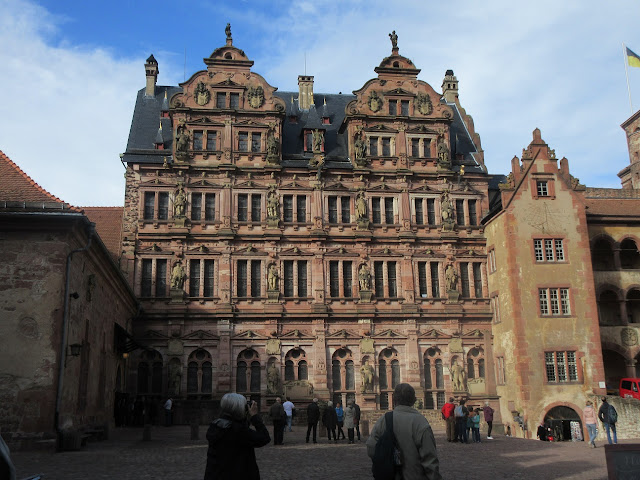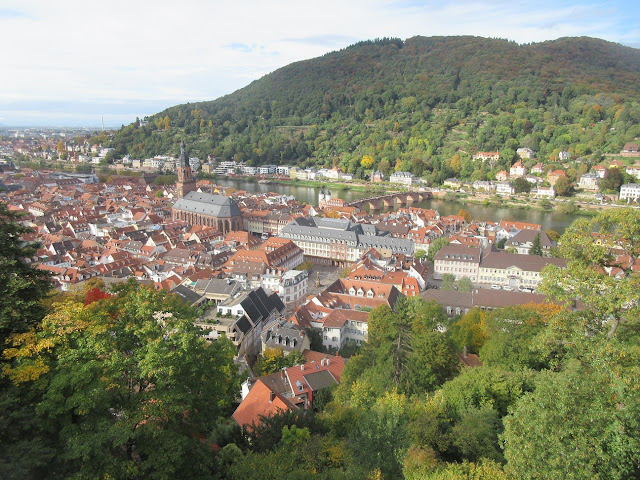Thursday's port-of-call for our Rhine cruise was the industrial port of Ludwigshafen, across the Rhine from the better-known industrial port of Mannheim. There is nothing of particular interest in either city for most tourists, unless you especially enjoy snapping pictures of endless miles of chemical plants (Ludwigshafen is the headquarters of the BASF chemical company).
But these ports are an easy jumping-off spot for the scenic glories of Heidelberg and Speyer. With a choice of tours, I opted for Heidelberg, little suspecting what I was in for.
Remember when I posted pics of the cobblestones in Prague and thought those were rough work to walk on? Well, in Heidelberg, the average height difference between adjacent cobblestones runs in the neighbourhood of 2-3 cm. Up at the ruins of Heidelberg Castle, the height difference grows to 5 cm or more -- sometimes much more. I've twisted my ankle in the past over curbs that were lower than those cobblestones!
By the end of the day, my bad knee was screaming insults at me in languages I didn't even realize I knew, and my walk from the bus back to the ship displayed a hefty limp that occasioned some comment at dinner time. (it's better today).
However, I'd have to say that it was worth it. I've rarely seen a ruined castle that has so much still standing. So here we go. First shot: a view of the ruins from the main square of the town below.
Once our bus had climbed the snaky little road to the crest of the hill, we walked through this gateway into the gardens of the castle.
We then enjoyed a half-hour walk around the extensive ruins. The castle was reduced to ruins when this part of the Palatinate was invaded by France during the War of the Grand Alliance and the War of the Palatinate Succession. Thank you, Louis XIV. I bet he was just jealous because the setting was so much more spectacular than the tiny little fake hills he had to build at Versailles.
Wait a minute -- those are actual windows, aren't they?
Yes, they are. In the 1700s and early 1800s, work had begun to restore the structures. This restoration had progressed as far as the central block of the seventeenth-century palace wing before the arrival of the Romantic movement in art and literature, which decreed that a decomposing ruin was just as splendid and evocative as a newly-completed building. The palace as it stands, with all of its elaborate sculptural decorations, is still very impressive.
If you go down the steep and roughly cobbled path to the arch under the tower at the right side of the palace, you can descend into the vaulted cellars to view the most remarkable artifact of Heidelberg Castle: the Great Vat.
The largest single oaken wine cask every built, this monster barrel was filled only once -- and began to leak, because of its sheer size, before it was even close to half-full. In a nearby recess stands this relatively small (even trivial, by comparison) earlier effort.
However, before we get all excited about the potential for swimming in wine at the greatest drunken party of all time, we must remember that wine in those days was heavily diluted with water and then sweetened with various other substances, and therefore didn't have nearly as much of a kick as the wines we know today.
Pity.
At several different points there are terraces which give spectacular views of the town of Heidelberg and the Neckar River far below. In one picture, you will see a dam and a lock. Yes, the Neckar River is navigable, but the locks are too old and small to be used by modern river cruise ships -- and the cost to enlarge them would far exceed any potential benefit to the area.
You can hike down the hundreds of steps from the castle to the main area of town if you like. After climbing up that brutal cobbled ramp from the Great Vat, I (or my knee, to be precise) did not like.
Fortunately, our tour included a relatively easy ride down the hill in the funicular, which brought us to the town centre in 90 seconds. About a minute's walk then led us to the first of two sizable squares, the Corn Market. The pillar in the middle of the square is crowned by a Virgin and Child which was placed here as an instructive warning to any stubborn Protestants, during one of the periods when the town was controlled by Catholics during the endless wars of religion.
From there, it was a short further walk to the Town Hall Square, home of the Church of Our Lady. This church is a perfect representation of the endless religious flip-flops in Heidelberg's history. With a form of dedication which is almost always used for Catholic churches, the coolly austere interior is the epitome of Lutheran (or even Calvinist) belief, right down to the lack of pictorial images in most of the windows.
I sat and stared in fascination at the apse end of the church, trying to analyze the peculiar pattern of the tracery in the roof, since I'd never seen anything quite like it before. I finally figured out the secret. The inner rank of arches takes 5 arches to form the semi-circular bay at the east end of the church, but the outer wall uses eight windows in eight arches to cover the same semi-circle. It's no wonder the roof tracery looks symmetrical, yet somehow cockeyed at the same time.
To cap off my visit, I walked down to the bank of the river, which is lined with some lovely old hotels, in order to get a closer look at the old sandstone bridge and its gate tower.
Here's where I took my daily "Kilroy-was-here" moment.
I also climbed up onto the bridge, and discovered, to my amusement, that the lovelock craze has even spread here, although on a much smaller scale -- it's hard to find a place to anchor them!



























No comments:
Post a Comment